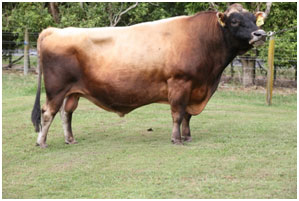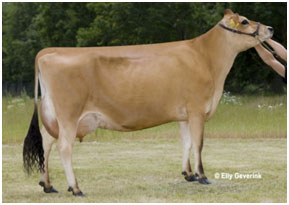 |
|
 |
|
Jersey Bull |
|
Jersey Cattle |
Jerseys are a small breed that is fawn brown in color. Because of their color and the shape of their eyes, they are often described as “deerlike.” They originated on the Isle of Jersey in Great Britain. The Jersey’s milk is rich and high in butterfat, so it is usually considered the best-tasting milk. It is also known for the lower maintenance costs attending its lower bodyweight, as well as its genial disposition.
General Information:
- Species: Cattle
- Synonyms: Dairy Queen, Farmer’s Jersey.
- Habitat: The Jersey can now be found across the world with a large population in Countries such as Australia, Canada, Denmark, New Zealand, South Africa, USA, and Zimbabwe, as well as in the UK.
- Breeding tract: However, the breed is bred only in temperate zones but in India breeding is largely confined to organized herds only whereby standard management and housing conditions are required for dwelling of the cattle. Areas of Punjab, Haryana, Tamil Nadu, Karnataka, Uttar Pradesh and Delhi have some private farms dealing with breeding of Jersey.
- Main utility: Milk for food
- Origin: However, the breed is bred only in temperate zones but in India breeding is largely confined to organized herds only whereby standard management and housing conditions are required for dwelling of the cattle. Areas of Punjab, Haryana, Tamil Nadu, Karnataka, Uttar Pradesh and Delhi have some private farms dealing with breeding of Jersey.
- Distribution: Europe, North America, Southern Parts of Africa, South Asia.
Phenotypic traits:
- Colour: Fawn, ranging from light fawn to tan. Saddle is tan in color.
- Number of Horns : 2 (mostly polled cattle is found)
- Visible characteristics: Tan saddle, capacious udder, stout and angular body, lighter coloration around their noses and eyes, and on the inside of each leg.
|
|
|
Male
|
Female
|
|
5. |
Height (Avg. cm)
|
137 |
133 |
|
6. |
Body length (Avg. cm) |
150 |
139 |
|
7. |
Heart Girth (Avg. cm)
|
189 |
180 |
|
8. |
Weight (Avg. Kg) |
600 |
580 |
|
9. |
Birth Weight (Avg. Kg) |
38 |
35 |
|
10. |
Length (Avg. cm) |
152 |
141 |
Physical Characteristics:
- Body Color: Generally fawn, ranges from brown to tan. Light fawn is generally found in most of the Jersey cattle. A lot of fawn-colored mature cattle have a darker face from just below their poll or just above their eye-brows to just before their noses.
- Body Size : Shorter and stout body. Jerseys look to be more finer-boned and bodied than most any beef breed or even Holsteins. Just like Holsteins, though, Jerseys are quite angular in body type because they are selected to be a milk-producer and not a beef-producer.
- Head : Jersey cows are very feminine looking animals, with a finer, more feminine head.
- Horns : Jerseys are a naturally horned breed, though there are genetics for polled cattle as well.
- Temperament : Docile and is a distinctive dairy animal. The bulls are very aggressive.
- Face : Small face as compared to bodily characteristics
- Ears: Ears are of small size.
- Dewlap : slight.
- Udder: Capacious & Pendulous, Massive in size with prominent milk vein.
- Hump : Absent.
- Withers: Round
Breed helpful in raising economy of the farm:
The Jersey cow is quite small, ranging from only 400–500 kilograms (880–1,100 lb). The main factor contributing to the popularity of the breed has been their greater economy of production, due to:
- The ability to carry a larger number of effective milking cows per unit area due to lower body weight, hence
lower maintenance requirements, and superior grazing ability.
- Calving ease and a relatively lower rate of dystocia, leading to their popularity in crossbreeding with other dairy and even beef breeds to reduce calving related injuries.
- High fertility.
- High butterfat conditions, 4.84% butterfat and 3.95% protein, and the ability to thrive on locally produced food. Bulls are also small, ranging from 540 to 820 kg (1200 to 1800 pounds), and are notoriously aggressive.
- Castrated males can be trained into fine oxen which, due to their small size and gentle nature, make them popular with young teamsters. Jersey oxen are not as strong as larger breeds however and are generally out of favor among competitive teamsters.
Jersey versus Guernsey:
Jerseys are not to be confused with Guernseys. Though both names sound the same, they are two entirely different dairy cattle. Guernseys neither have the fawn coloration nor have dark eyes, nose, hooves and tail switch that Jerseys have, and are brown in color than fawn, and have more white on them than a typical Jersey would.
Management:
- Management System: Intensive
- Mobility: Stationary
- Feeding of adults: Fodder and Concentrate
- Housing: Well developed housing for organized herds
- Feeding system: Stall feeding
- Feeds to be fed: Berseem, oats and mustard are the green fodder in rabi; and sorghum, pearl millet and cluster bean in kharif. Commercial feed can be fed anytime of the year. . Milking cows are provided supplementry feeding in the form of cotton seed, barley and oil cake. Feed is given in soaked form at the time of milking. Calves are reared on whole milk up to 1 month of age after which some green fodder is also fed. Calves are allowed to suck 1-2 teats up to 6 months of age. The adult cattle is also fed silage for better milk production.
- Feeding of concentrates: 1kg/2kg milk at the time of milking.
- Feeding of roughages: 1/10th of body weight per day.
- Milking: Should be done 2-3 times a day, however thrice a day milking gives higher milk yield.
- Milking practice: Full hand milking should be done. Avoid knuckling. Machine milking is generally practiced.
- Milk let down time: 4-5 minutes.
Performance traits:
|
|
Average |
Minimum |
Maximum |
|
Age at first calving (Avg. months) |
28 |
26 |
30 |
|
Calving interval (months) |
13 |
12 |
14 |
|
Lactation length (days)
|
305 (standardized) |
- |
- |
|
Milk yield per lactation (kg) |
5600 |
4500 |
10,550 (record) |
|
Milk fat (%) |
4.84 |
3.87 |
5.17 |
|
Daily lactation in peak period (kg) |
18.3 |
13.6 |
34.5 (record) |
|
Dry period (days)
|
60 |
55 |
70 |
- Peculiarity of the breed:
- All Jerseys have dark eyes and dark pigmented skin around their eyes and their noses. They also have black hooves and a dark tail-switch. Those dark noses and dark eyes in Jersey calves make them look adorably cute, much more so than any other bovine calf of any other breed.
- After the Holstein the Jersey is the second most popular specialist Dairy breed world-wide. Jerseys thrive under both extremes of temperature - they can grow thick coats in very cold climates, whilst suffering form much less heat stress than the other dairy breeds in hotter regions of the world.
- Despite her small size the Jersey is renowned for its ease of calving, allowing it to be crossed with the larger beef breeds.
- Research highlights:
- Jersey cow produces milk more efficiently than other breeds. This can be especially important in countries where feed may be restricted. As well as making the Jersey a profitable option in agriculturally developed countries.
- 2. Many herds of Jerseys in the UK now average well over 5000kgs of milk produced per cow per year, with the best individual animals yielding around 9000kgs or higher.
- Jersey milk is in many ways unique. As a product it contains 18% more protein, 20% more calcium, 25% more butterfat than "average" milk.
Major problems associated with health of Jersey Cattle:
- Mastitis: Being very high yielding cattle, the risk of mastitis is always present.
- Calcium Deficiency: The cattle should be supplied with Calcium and Phosphorous supplements to maintain the health of animal.
- Genital Diseases: The risk of genital diseases like pyometra, metritis, is always present and should be taken care of.
- Unfortunately, they have a greater tendency towards post-parturient hypocalcaemia (or "milk fever") in dams and frail calves that require more attentive management in cold weather than other dairy breeds due to their smaller body mass and greater relative surface area.
Price range:
Rs. 80,000/- to Rs. 2,50,000/- (tentative)
Can be purchased from:
1. Gupta Dairy Farm:
Address: Plot No. 41-42, Govind Colony, Near water tank, Doon Valley College Road, Jundla Gate, Karnal-132001, Haryana.
Phone no. 09416031427.
Website:
www.guptadairyfarm.com
Email:
guptadairyfarm@gmail.com
2. Khurana Dairy Farm, Rohtak, Haryana.
Mobile Number : +91-9215450001 / 9215430001 / 9215450003
3. Model Dairy Farm: Mr. Prateek Vaish (VP-Operations).
Address: Naramau, GT Road, near ALIMCO, Kanpur-209217, UP.
4. Karnal Livestock Sales.
Contact Details: Dabas House, 17-E, Session Road, Karnal - 132001, Haryana, India,
Mr. Anand Parkash Dabas (Proprietor).
5. Anand Cows Sales and Dealership.
Contact Details: K. amanyam Raju, S/O K. Narayana Raju,
Kothaindlu, Punganur(P&T), Chittoor - 517247, Andhra Pradesh, India.
Mobile : +918497009383.
6. Sachdeva Dairy Farm: Mr. Anil Sachdeva,
940/31, Buffalo Market,Behind Durga Bhavan Mandir,, Rohtak, Haryana, India – 124001.
Mobile : +91-9896146700
Website:
http://www.sachdevadairyfarm.com
Webpage: http://www.exportersindia.com/sachdevadairyfarm/
7. Chaudhary Dairy Farm. Contact Details: Mr. Arvind A Chaudhary
Address: Chaudhary Dairy Farm, Mewad. Tal. & Dist.Mehsana, Gujarat.
Mob No: 9898816448
External Links:
1. http://www.nbagr.res.in/
2.
www.guptadairyfarm.com
3.
http://www.khuranadairyfarm.in/
4.
http://www.modeldairyfarm.com/
5.
http://www.karnallivestocksales.com/
6.
http://www.sachdevadairyfarm.com/
|


